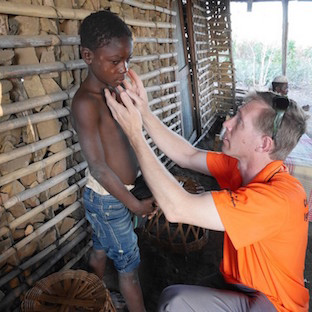Breakthrough in leprosy diagnosis using smartphone

Leprosy checkup in Mozambique
Two Christian Charities, The Leprosy Mission England and Wales ('TLMEW) and St Francis Leprosy Guild ('SFLG') are jointly funding multi-spectral screening research that aims to significantly speed up the diagnosis of the biblical disease leprosy using a smartphone.
Despite a cure for leprosy being freely available since the 1980s, over 200,000 cases of leprosy are diagnosed every year. More significantly, research suggests that for every person diagnosed, a further 20 go undiagnosed. This means that millions of people are potentially at risk from catching or spreading leprosy. If left untreated, leprosy causes nerve damage which can lead to irreversible disability and disfigurement, including blindness.
Sian Arulanantham, Head of Programmes and Policy at TLMEW said: "Pioneering diagnostic tools such as multi-spectral screening are desperately needed to diagnose leprosy quickly and accurately in the remote areas of Asia and Africa where we work."
"There are so many communities that don't have access to hospital-based skin smears and biopsies, which are also costly and invasive."
"A health worker armed with the technology to diagnose leprosy more accurately with a scanner on a smartphone is such an exciting prospect. A person with leprosy can be treated immediately and spared a lifetime of disability."
"Such a device would be an immensely valuable tool in our mission to end leprosy. We are incredibly grateful to SFLG for funding this groundbreaking research with us."
Clare McIntosh, SFLG Director said: "We are delighted to be supporting this exciting research project. An easy-to-use, field diagnostic is the vital tool that we need to find the many people affected by leprosy and stop its transmission."
She added: "As part of our TRACE operating strategy for people with leprosy (Train, Research, Active Case Finding, Care, Emergency support), SFLG is committed to active case finding and research. If we are to see an end to leprosy in our lifetime, we must invest in new tools that help find and diagnose people with leprosy and finally prevent this disease for destroying lives. We are grateful for the continued support of our donors enabling us to explore advances like these."
Every year, TLM and SFLG train thousands of health workers and volunteers to diagnose leprosy. However, diagnosis can be tricky as leprosy may be confused with other skin diseases. Often health workers do not have adequate clinical skills, especially when dealing with early cases of leprosy. In such instances, the patient is given a skin smear or biopsy to confirm a diagnosis. But in remote rural areas where SFLG and TLM operate, there are no such facilities.
Professor Janis Spigulis and his team at the University of Latvia are undertaking groundbreaking research into multi-spectral screening, specifically the absorption and scattering of light of skin lesions and, the development of mobile screening devices to diagnose skin abnormalities.
Spectral screening has been used successfully to detect melanoma, the deadliest form of skin cancer. Digital technology has meant that suspect lesions can be immediately screened against a database. The database provides scoring factors that significantly increase accuracy of initial clinician decisions.
In collaboration with TLM, a one-year research project is now underway at TLM's Anandaban Hospital in Nepal, to test the efficacy of multi-spectral screening on leprosy lesions. A baseline scoring of digital images of leprosy classifications can then be developed and cross-referenced with other common skin conditions, such as dermatitis.
The next step is to apply a screening device to a smartphone. This will enable volunteers and health workers to have in their hands the ability to diagnose a leprosy lesion in minutes.
The project has secured funding from the Neglected Tropical Disease Innovation Prize and The Leprosy Mission New Zealand. A £5,500 contribution from St Francis Leprosy Guild will enable the research project to be completed.
LINKS
St Francis Leprosy Guild - www.Stfrancisleprosy.org
The Leprosy Mission - www.leprosymission.org.uk/#/
Leprosy is a mildly-infectious disease caused by a bacterium called Mycobacterium leprae (a relative of the tuberculosis bacterium or 'TB' germ). It can stay in the body for up to 30 years without showing symptoms. It causes nerve damage and, if left untreated, can lead to a loss of sensation and movement around the eyes, hands and feet. This can lead to disability and the amputation of limbs. Leprosy also damages nerves in the face causing problems with blinking, eventually leading to blindness.
Leprosy is not hereditary. An estimated 95% of people, if exposed, would never develop leprosy due to having normal, healthy immunity.
It is most common in places of poverty where overcrowding and poor nutrition, housing and sanitation allow people to become more susceptible to leprosy infection. At highest risk are those in households living in long-term, close contact with an untreated member(s) having leprosy. This is why early diagnosis and screening contacts is important.
The last case of indigenous leprosy in the UK was diagnosed in 1798; and although it is no longer contracted in this country, around 12 new cases are diagnosed in the UK each year.
Leprosy is curable with Multidrug therapy (MDT), a combination of three antibiotics taken for 6-12 months.
Whether before, during or after treatment - built-up leprosy bacterial residues can make patients vulnerable to unpredictable and long inflammatory episodes called leprosy reactions - which can lead to nerve damage and disability development even years after technical cure. Besides limiting transmission, this is why early diagnosis is so important.
Lack of education, however, means that many people affected by leprosy are still stigmatised, even after they have been cured, especially if the disease has caused disability.
Latest statistics reveal in 2019 there were 202,185 new cases of leprosy diagnosed. There is evidence to suggest that for every person diagnosed with leprosy today, there are a hidden 20 who need the cure.


















